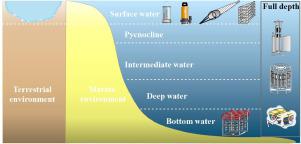Water Research ( IF 11.4 ) Pub Date : 2020-09-09 , DOI: 10.1016/j.watres.2020.116403 Kai Liu 1 , Winnie Courtene-Jones 2 , Xiaohui Wang 1 , Zhangyu Song 1 , Nian Wei 3 , Daoji Li 1

|
There have been numerous studies that have investigated floating microplastics (MPs) in surface water, yet little data are currently available regarding the vertical distribution in the water column. This lack constrains our ability to comprehensively assess the ecological effects of MPs and develop further policy controls. In this study, we reviewed current progress of sampling methodologies, the distribution patterns, and the physiochemical properties of MPs throughout the water column. Three sampling protocols were identified in this study: bulk, net and submersible pump/in-situ sampling. In different regions, the vertical patterns of MPs in the water column varied with depth, which is possibly related to the morphological characteristics, polymeric densities, and biofouling of the MPs. The results of this review revealed that fibrous and fragmented MPs comprised over 90% of the total MPs by quantity, of which fibrous MPs constituted the majority (43%–100%). In addition, polyethylene terephthalate, polyamide, polyethylene, polyvinyl chloride, and polypropylene have been widely identified in previous studies. To minimize the impact caused by various sampling protocols, the use of a volume gradient trail experiment and a unified mesh size of 60–100 μm for the initial concentration are recommended according to the results of this review. Given the limited knowledge regarding the vertical transport of MPs in the water column, harmonized sampling methods should first be developed. The mechanisms of this process can be separately considered for different water bodies, such as freshwater systems, coastal waters, and pelagic zones. The presence of these anthropogenic pollutants in the water column poses a threat to the largest but most vulnerable habitats of life on earth, and hence they merit further investigation.
中文翻译:

阐明水柱中微塑料的垂直运输:抽样方法和分布的回顾。
已经有许多研究调查了地表水中的漂浮微塑料(MPs),但有关水柱中垂直分布的数据目前很少。这种缺乏限制了我们全面评估国会议员的生态影响和制定进一步政策控制的能力。在这项研究中,我们回顾了整个水柱中MP的采样方法,分布模式和理化特性的最新进展。本研究确定了三种采样方案:散装,净泵和潜水泵/原位采样。在不同区域,水柱中MP的垂直模式随深度而变化,这可能与MP的形态特征,聚合物密度和生物结垢有关。审查结果显示,按数量计,纤维状和碎片状MP占MP总数的90%以上,其中纤维状MP占多数(43%至100%)。另外,在先前的研究中已广泛鉴定出聚对苯二甲酸乙二醇酯,聚酰胺,聚乙烯,聚氯乙烯和聚丙烯。为了使各种采样方案所造成的影响最小化,根据本次审查的结果,建议使用体积梯度试验和初始浓度统一为60-100μm的筛孔。鉴于有关MP在水柱中垂直运输的知识有限,应首先开发统一的采样方法。对于不同的水体,例如淡水系统,沿海水域和中上层带,可以分别考虑此过程的机制。









































 京公网安备 11010802027423号
京公网安备 11010802027423号